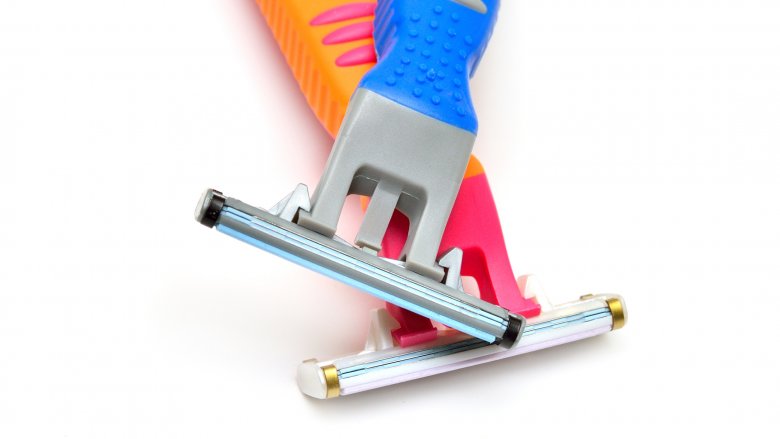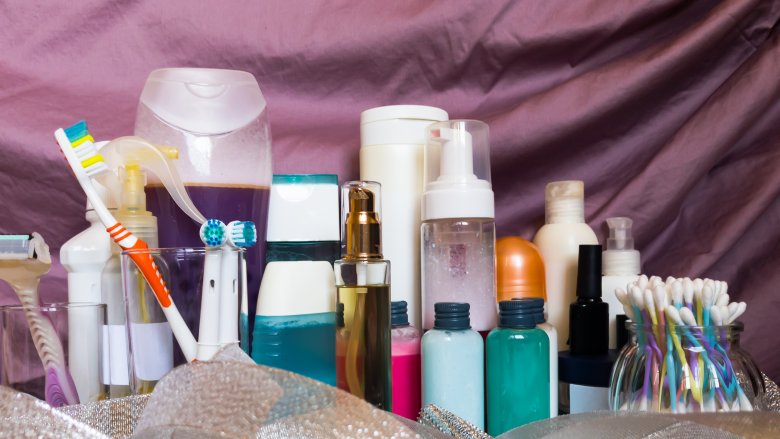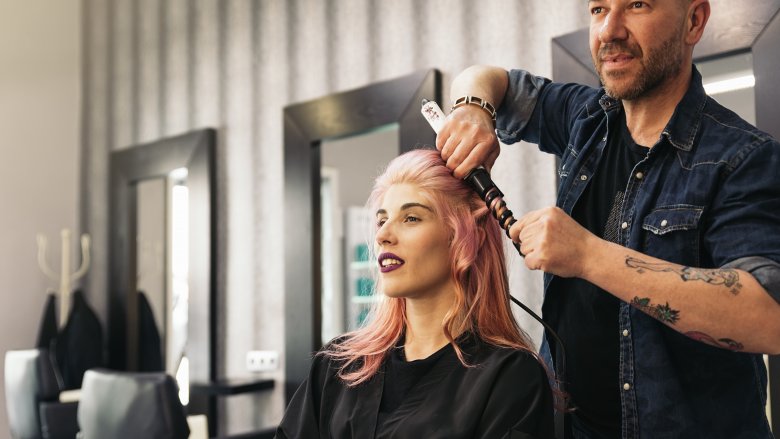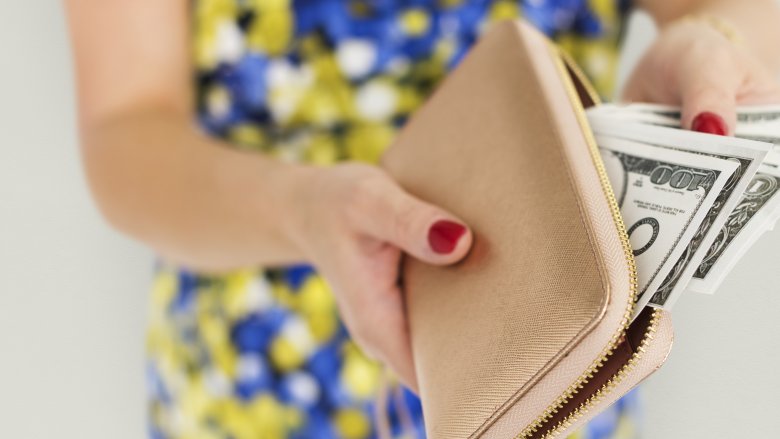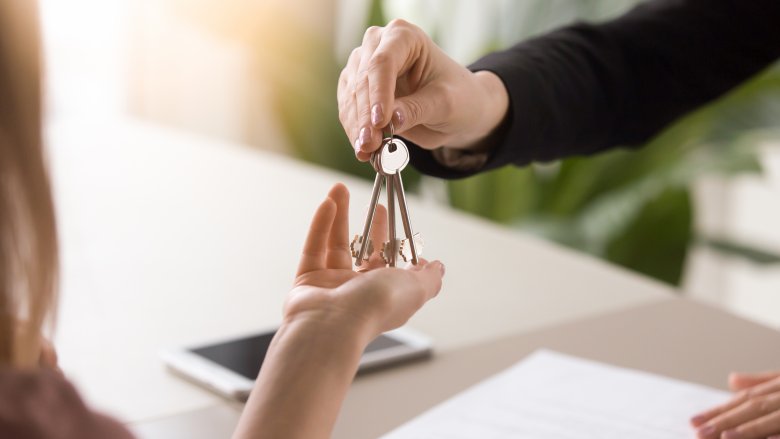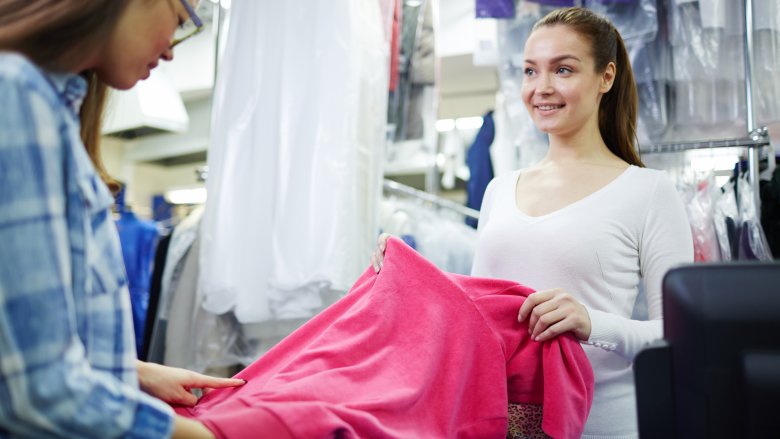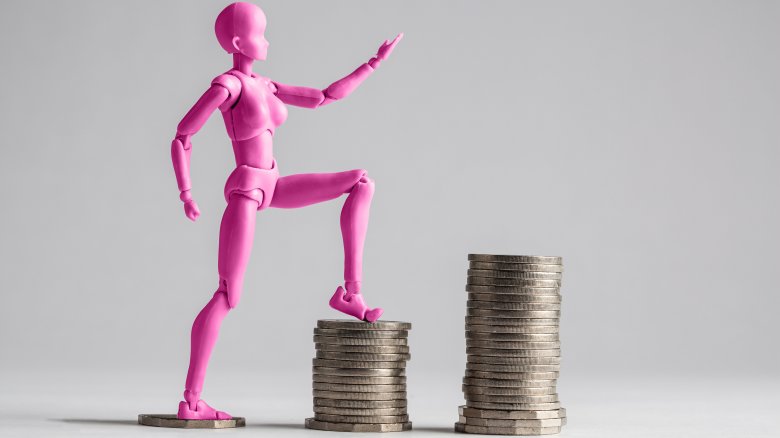Things Women Always Pay More For
There's no denying that it's an interesting time to be a woman, to say the least. Regardless of where you land on the political spectrum, it's hard to deny that there are times when women just aren't treated the same as men. Case in point, the wage gap. In 2015 in the United States, women working full-time made, on average, just 80 percent of what men made. Just to spell it out, that's 80 cents for every dollar a man makes. This varies somewhat from state to state, between 64 percent and 89 percent, but in no state in the United States in 2015, did women on average make the same amount as men, and it isn't because their jobs are different.
While the wage gap is an entirely separate discussion worthy of its own dissection, we're here to talk about not what women make, but what women pay. That's because despite getting paid less than men, there are many items that, while pretty much identical, women pay more for. Well, they're identical except for the fact that they're often pink, hence this phenomenon of female-marketed products costing more than male-marketed products being dubbed the "pink tax." It isn't just material goods, either. Here are just a few of the things women always pay more for.
Razors and cartridges
In a study on gender pricing in New York City, researchers found that razors and cartridges cost, on average, 11 percent more for women than for men. Though the study was conducted in New York City, the disparity exists nationwide. This is such big deal that the Dollar Shave Club, a subscription box company that sends you razors and cartridges each month, has devoted a chunk of their marketing to specifically to it. Boasting on a Facebook post, "You don't need a pink razor to get a badass lady shave. Shave with high quality blades for just a few bucks a month."
But Dollar Shave Club isn't the only subscription razor service around. In fact, there are some that are marketed directly to women. What's that? The women's subscription box costs more? Yep. While Dollar Shave Club's options range from $3 to $9 per month, depending on the type of razor you'd like (The Executive, The 4x, or The Humble Twin), Angel Shave Club — "The Boutique Shave Club for Women" — offers just two options, the least expensive starting at $6 per month. Before you suggest that the $3 per month razor from Dollar Shave Club only has two blades, note that both companies have a $6 option. The $6 razor from Angel Shave Club has three blades compared to the $6 razor from Dollar Shave Club, which has four.
Any way you slice it, the "women's" razors still cost more.
Health and beauty items
While razors can certainly be included in the category of health and beauty items, it's worth noting that other products in this category are also more expensive for women, than men. This includes deodorant, lotion, shampoo, conditioner, and body wash that all cost more if you get the versions targeted toward women.
That same study on gender pricing in NYC found that women pay 11 percent more for lotion, six percent more for body wash, three percent more for deodorant, and a whopping 48 percent more for shampoo and conditioner! Even though the study was conducted out of NYC, researchers looked at different brands and stores (as well as online), "including high-end, low-end, and median price ranges" and the differences persisted.
To add insult to injury, according to StyleCaster, a lot of these products share the same ingredients, with the only differences being packaging and fragrance. Also, be sure to look at the size! The NYC gender pricing study found that sometimes the prices for products were similar, but that's because the men's product came in a larger size, equating to women paying more for less. In this case, size does matter.
Haircuts
It isn't just the beauty and styling products that cost more for women, it's haircuts too. While you could maybe argue that women's haircuts are more elaborate than men's, that's a distinction that's becoming less-defined. Even when a man's hair is as long as a woman's, or when he's looking for just as many services, he's still likely to get a better price. Similarly, women with very short, traditionally "male" haircuts, still pay more than the men who get the same cut.
Klara Vanova, who runs a genderneutral barber shop, told BBC News that the price differential really is price discrimination. "Traditionally in hairdressing, women are charged much more than men, and if they challenge it then they say, oh, women's hair is different," she said. "So I would like to say, there is no difference between men and women haircuts or hair. It is just simply that in the hairdressing industry you will pay more if you are a woman." While some salons are making the switch to gender neutral pricing, it may be a long time before we see a new status quo.
Cars
With many of the other items, you could potentially argue that the requirements are different for women's products. Maybe razors have to be designed differently, beauty care items necessitate different ingredients for a woman's needs, and women's haircuts take longer. While that's still a weak argument, as we've already outlined, it doesn't begin to explain why cars are more expensive for women.
Sadly, we've known since at least the '90s (maybe even earlier) that this is the case. A 1991 study in the Harvard Law Review offered evidence that car dealerships offered much better prices to white men than those offered to black men or women of any race. In this research, white women paid 40 percent more than white men and black men paid three times as much as white men. When they talked to people of their own race or gender, they actually got even worse deals! While you may think those days are long gone, several follow-up studies have show this persists even when test-buyers are trained to negotiate in identical ways. So it isn't about men being better hagglers, women really do pay more for cars, regardless.
Car repair
If it isn't bad enough that you'll pay more for your car if you're a woman, even your car repair will cost more. A study out of Northwestern University and the National Bureau of Economic Research had both men and women call repair shops to ask how much it would cost to have a radiator replaced. When women and men acted as if they had no idea how much the repair should cost, they were quoted different prices. The women were quoted $406, while men were quoted $383.
When both men and women told the person on the phone that they knew the repair should cost $365, there was no difference in the prices they were quoted. So while both men and women were taken advantage of for "not knowing any better," the women would have ended up paying more.
Loans and credit
You would think that while material goods might be one thing, surely that's where it ends. Unfortunately, research has found that women pay more than men when it comes to loans and credit. That is, women's interest rates on loans and credit cards is higher than for men. A 2013 study in Italy found this is true regardless of what bank is chosen, the borrower's other characteristics, his or her credit history, and the structure of the credit market. According to the researchers, the exact same banks charge different rates for men and women, despite lack of evidence that women are "riskier" for credit.
Another study out of Brazil found that while women are no more likely to be denied outright for a loan, their loans have a lower glass ceiling, meaning it's harder for women to be approved for loans as large as those for men, even when controlling for other factors.
Mortgages
It isn't just personal loans and credit cards that women pay more for when it comes to loan and credit, either. Women also end up paying more for their mortgages than men. It's frustrating enough that women are denied mortgages more frequently than men, but when a woman does manage to get a mortgage in her name, it's going to cost her.
A study in The Journal of Real Estate Finance and Economics found that women pay more on average for their mortgages than their male counterparts. According to the researchers, this wasn't because of differences in the mortgages themselves (home value, terms, etc.), the condition of the market, or features about the borrower (like their credit scores). The researchers do suggest, however, that it may be because women don't do as much research as men prior to getting a mortgage.
While this may be the case, a more recent study found that predatory practices in which people who had previously been unable to get mortgages (women and minorities) were targeted for subprime mortgages right before the housing bust, suggests discriminatory practices based on both race and gender. While this suggests that it's possible for women to get the same mortgage rates as their male counterparts, they may have to work a lot harder to get them.
Clothes
From jeans to sweaters and work clothes to socks, women's clothes cost more. Sure, there are some legitimate reasons this might be the case, especially when it comes to different kinds of fabrics, detail work, additional embellishments, etc. But it turns out that even when these differences are taken into consideration, women's clothing still costs more than men's clothing.
Old Navy ran into trouble in 2014 when customer Renee Posey noticed that while plus size women's jeans were more expensive than the smaller sizes, men's larger sizes were the same price as the smaller sizes. While Posey said in an online petition that she was okay with paying more for larger clothing because of the extra material required, she was surprised to see that men's clothing didn't receive the same price increase for the extra material. She wrote, "Selling jeans to larger-sized men at the same cost as they sell to smaller men not only negates the cost of manufacture argument, but indicates that Old Navy is participating in both sexism and sizeism, directed only at women."
A writer at GQ, who admits this is an issue with designer clothing as well, points to the possibility that women are charged more because, by and large, they're willing to pay it. She said, "Men are thought to approach buying clothes with more pragmatism, which prevents retailers from hiking up prices without reason." Just because you can get away with something doesn't mean you should.
Dry cleaning
Once you get the clothes, you're still going to pay more because dry cleaning is more expensive for women. A 2011 study in Gender Issues found that the average price to get the same clothing items cleaned was more for women than for men, even when controlling for things like specialty fabrics or embellishments that might require more time and care (like sequins, fringe, etc.).
CBS News went undercover to test this out. A male producer and a female producer each visited dry cleaners in New York City, with a similar item (what they describe as "100 percent cotton button down shirts in comparable sizes"), and asked for the exact same service. In over half of the dry cleaners that were visited, the female producer was charged at least twice as much as the male producer.
It starts in childhood
While kids don't have to worry about mortgages, dry cleaning, or shaving products, they're unfortunately not immune to cost (and marketing) differences based on gender. In recent years, many stores have caught flak for gender-specific marketing that has been deemed sexist. While many of these complaints have been based on the fact that toys are separated into "toys traditionally for boys" and "toys traditionally for girls" in catalogs and stores there is also an issue when it comes to the price of identical products.
Girls' toys, clothes, craft supplies, bikes, and backpacks all cost more than than the same products for boys. Fortune reported on an analysis conducted by the pricing consultancy company Boomerang Commerce that looked at 50 different products on multiple major web retailer sites that all offered options for color selection. The products covered 17 different categories, including toys, clothing, and electronics. All of the products were offered in several different colors, including pink. The pink version was more expensive in every single case.
Interestingly enough, while the products weren't explicitly called boys' or girls' products, the images on the various sites showed girls with the pink products and boys with the other products. Also interesting, while the manufacturers' prices were also somewhat higher for girls' products, the biggest differences came when the retailers themselves had a special offer price.
What to do about it
If you're starting to feel frustrated with all this info, you're not alone. Luckily, there is hope. Some states, like California, have laws against gender discriminative pricing. The more people know about these kinds of issues, the more people can talk to their representatives in Washington to soon get laws like these passed in every state.
There is even a bill currently in Congress, called the Pink Tax Repeal Act that was introduced to the House of Representatives by a California representative in July 2016. Unfortunately, it seems to have stalled there. In the meantime, avoid the retailers that charge the highest pink tax and seek out those that are attempting to counter it. Just say no to the pink tax.

